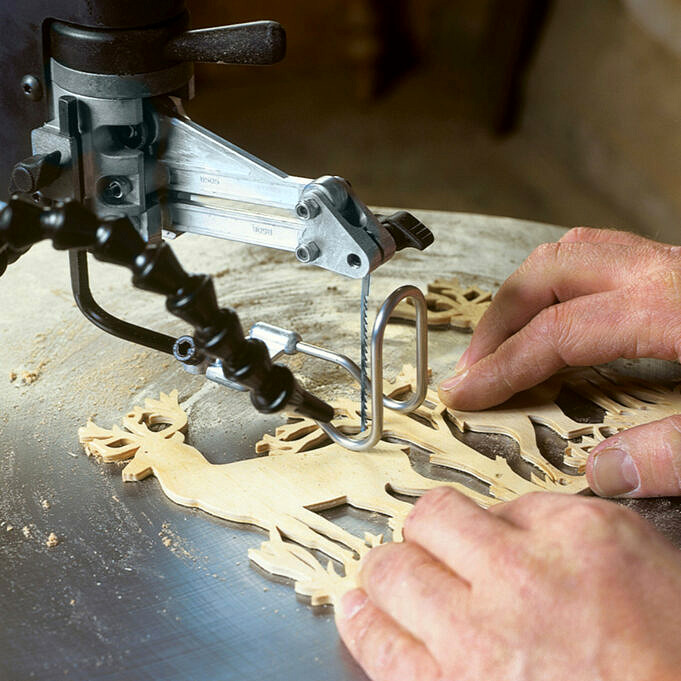A scroll saw is used for making intricate cuts. You may need a different blade to make the precise cuts you require. This guide will demonstrate how to attach a scroll saw blade to your machine.
Step One
Locate the blade tension knob. It is usually located at the top of your machine. Before you move on, make sure that your machine is unplugged.
Step 2
Loosen the tension knob a few turns by turning it counter clockwise with your fingers or a flat head screwdriver. You dont want to turn it too much, just enough so that the blade slides easily through the hole in the upper arm of your scroll saw without dropping down between grooves of metal that are used to secure your blade in place.
Step Three
Pull out the old blade by pulling up on the release lever attached to the upper arm. Then, hold the new blade with one hand. The release lever may be tricky to locate because it looks similar to other levers on your machine, so be sure to read your manual for assembly and disassembly before attempting the removal of your blade.
Step Four
Place the new blade in the upper arm, making sure that the teeth face down towards your table. Place the lower release lever over the blade. Next, turn clockwise to tighten the knob closest to the release lever until it is tight but not too tight. If you have trouble loosening or tightening the tension knob, try using a flat head screwdriver or rubber gripper pad like those used for kitchen cabinets.
Step Five
Test out your new blade by scrolling through several different cuts. Be sure to keep hands away from moving blades while cutting; even blades designated scroll saw blades are very sharp and can easily cut through your skin. You can tighten the tension knob by turning it counterclockwise if you feel your blade is sliding too much.
Blade Clamps
Looking to get the most out of your scroll saw? A set of blade clamps is a must-have! These handy devices keep your blade in place, ensuring accurate and consistent cuts.
To install blade clamps, place them over the top of your scroll saw blade with the teeth pointing up. The blade will stay in place if the lever is released. To secure the blade in position, tighten the knobs at the clamps. This type of holding system is compatible with scroll saw blades that have clamp marks.
After you’ve installed your new blade, scrolling is now possible!
Styles of Blades
- You can scroll saw blades with the following profiles/makes:
- plain end (most common)
- Pin end (used to join individual pieces of wood together like dovetails).
- forstner tip (for making round holes in your workpiece)
- twist drill tip (making holes much larger than those made with a standard scroll saw blade)
- spiral tip (creating scrolls and curves on your projects without needing to rotate your workpiece very often)
- skip tooth blade (great for straight lines along the grain of your workpiece or cutting plywood on a table saw or radial arm saw)
How to choose new Scroll Saw Blade
you have many options depending on your needs. If you are making a large project with thicker wood, use an 18T blade. If you working on smaller projects or thin wood, then the scroll saw blades that range between 28 TPI to 44 TPI are suitable. Specialty blades can be purchased in lengths between 15 and 20 cm, in both pin-end and plain ends in Plano. These blades have extra strength to cut hardwoods such as oak and maple and fine-tooth variable pitch.
- plain end (most common)
- pin end (used for joining individual pieces of wood together, like dovetails)
- Forstner tip (for creating round holes in your workpiece).
- Twist drill tip: This allows for drilling holes that are larger than those made using a standard scroll saw blade.
- spiral tip (creating scrolls and curves on your projects without needing to rotate your workpiece very often)
- Skip tooth blade: Great for cutting plywood on a tablesaw or radial armsaw in straight lines along the grain.
The advantages of scroll saw blade
- You can use a saw to cut through wood, but not split it like a tablesaw.
- operates at lower speeds than a band saw or jigsaw to avoid tear-out and kickback which can be hazardous
- It is easier to transport and put together than a tablesaw & other stationary tools
Disadvantages of scroll saw blade
- To cut through the wood, you need to feed it constantly
- requires frequent blade changes when making large cuts
- Table is smaller than other types of saws
Conclusion
Scrolling saw blades come in many styles and types. You need to research your requirements and choose the right blade for you. Most scrolls saw blades come in the plain end and pin end styles, but there are specialty blades available in lengths from 15 cm to 30 cm in both plain end and pin end styles. You can also buy Plano extra strength blades for cutting hardwoods like oak or maple to fine-tooth variable pitch blades for detailed cuts.



